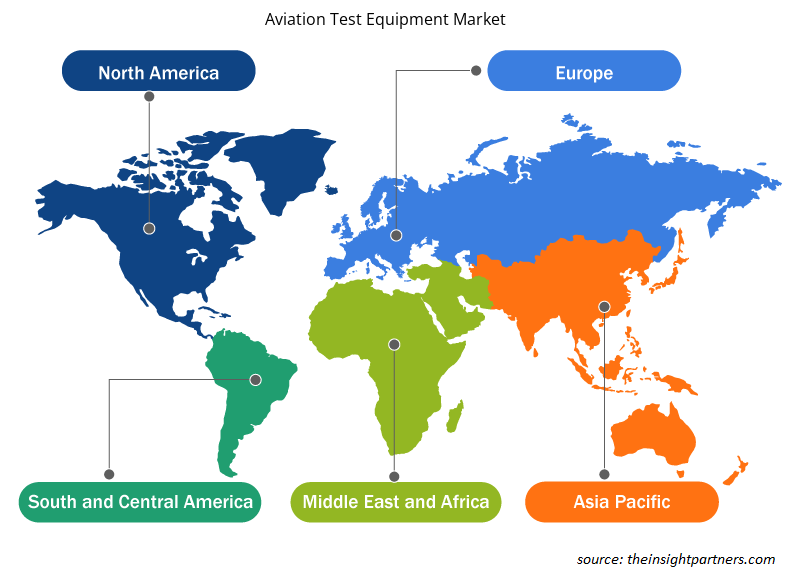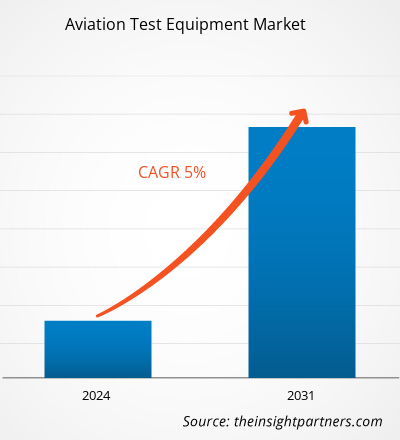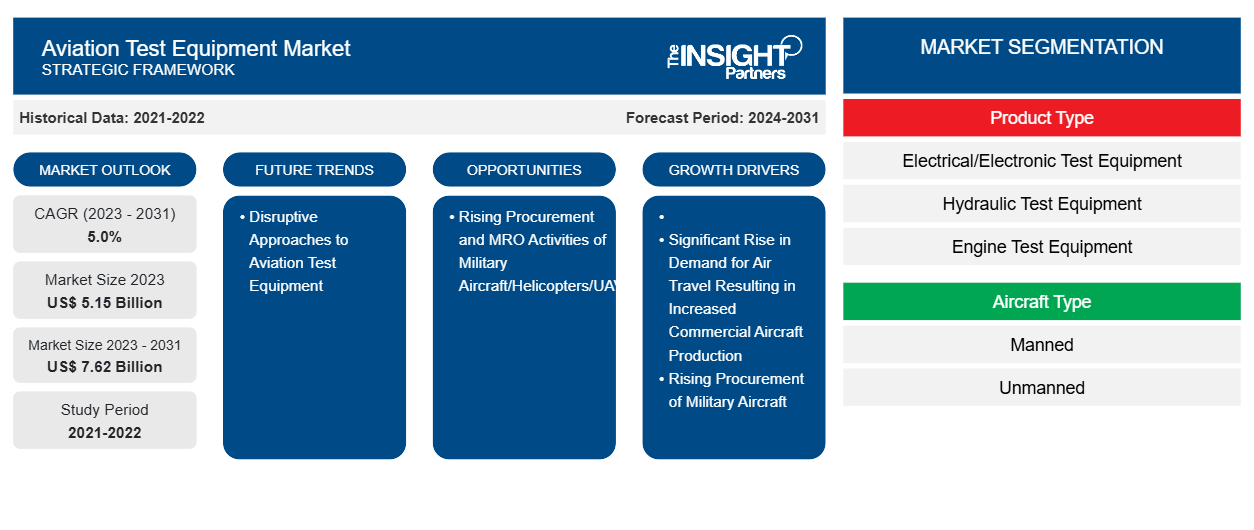항공 시험 장비 시장 규모는 2023년 51억 5,000만 달러에서 2031년까지 76억 2,000만 달러로 성장할 것으로 예상됩니다. 이 시장은 2023~2031년에 5.0%의 CAGR을 기록할 것으로 예상됩니다. 최근 몇 년 동안 차세대 기술이 도입되면서 항공 시험 장비가 발전했습니다. 예를 들어, 세계 최초의 조종석 제어판 로봇 테스터가 출시되었습니다. 항공 시험 장비 제조업체는 또한 항공기 시스템과 구성 요소의 시험 및 평가 프로세스를 단순화하는 파괴적인 혁신적 기술 모델을 도입하고 있습니다. 게다가 기업들은 상업용 및 군용 항공기 모두에 대한 완벽한 시험 솔루션을 제공하기 위해 힘을 합치고 있습니다. 예를 들어, Testek과 Avtron Aerospace는 개발에서 제조, 구성 요소 및 플랫폼 설계에 이르기까지 광범위한 항공기 시험을 제공합니다. 또한 Aero Maintenance Group LLC의 미국 자회사인 Barfield는 항공기의 우박 피해를 검사하고 평가하기 위한 3D 스캐닝 기술을 제공합니다.
항공 시험 장비 시장 분석
전 세계 항공기 제조업체는 항공 여행객, 군사 이동, 화물량 및 전투 준비 항공기의 증가로 인해 고객으로부터 상당한 수요를 경험하고 있습니다. 상업용 및 군용 항공기의 지속적인 조달 증가로 인해 항공기 제조업체는 더 많은 양의 테스트 장비를 조달해야 합니다. 항공기 제조업체의 이러한 장비에 대한 순수한 수요로 인해 테스트 장비 제조업체가 증가했습니다. 많은 수의 테스트 장비 제조업체는 제품, 리드 타임, 계약 평가 및 브랜드 가치에 따라 다양한 공급업체를 비교하는 데 도움이 되므로 구매자에게 이익이 됩니다.
항공 시험 장비 시장 개요
항공 시험 장비 생태계는 전담 절차를 추가로 포함하는 다양한 단계로 구성됩니다. 고객의 기대에 부응하기 위해 항공 시험 장비 시장에서 활동하는 시장 참여자는 견고한 제품과 서비스를 제공하기 위해 노력합니다. 전 세계적으로 운영되는 시험 장비 제조업체는 다양한 공급업체로부터 다양한 구성 요소를 조달합니다. 다양한 공급업체는 센서, 데이터 로거, 압력 게이지, 디스플레이와 같은 구성 요소를 공급합니다. 이러한 구성 요소 공급업체는 정기적으로 테스트 장비 제조 회사로부터 제품을 제공하라는 엄청난 압력에 직면합니다. 구성 요소 공급업체의 브랜드 가치는 최상의 품질 시험 장비를 제조하는 데 구성 요소의 품질이 필수적이라는 사실에 기인하여 매우 중요합니다. 장기적인 비즈니스 관계를 유지하기 위해 구성 요소 공급업체는 경쟁력 있는 가격으로 최고 품질의 제품을 제공하기 위해 노력합니다. 리드 타임도 구성 요소 공급업체가 강조하는 또 다른 매개변수입니다.
귀하의 요구 사항에 맞게 이 보고서를 사용자 정의하세요
이 보고서의 일부 또는 국가 수준 분석, Excel 데이터 팩을 포함하여 모든 보고서에 대한 사용자 정의를 무료로 받을 수 있으며 신생 기업 및 대학을 위한 훌륭한 혜택과 할인 혜택을 이용할 수 있습니다.
-
이 보고서의 주요 시장 동향을 알아보세요.이 무료 샘플에는 시장 동향부터 추정 및 예측까지 다양한 데이터 분석이 포함됩니다.
항공 테스트 장비 시장 동인 및 기회
항공 여행 수요의 상당한 증가로 인해 상업용 항공기 생산이 증가
글로벌 항공 부문은 새로운 항공기 모델에 대한 수요가 증가하여 전체 항공기 함대를 늘리는 것이 항공 테스트 장비 시장 성장을 주도하는 주요 요인 중 하나입니다. 증가하는 항공 승객 교통량은 항공기 조달 수를 더욱 증가시킬 가능성이 높고 항공 부문에서 테스트 장비에 대한 수요를 촉진할 것으로 예상됩니다. 또한 2022년 전체 상업용 항공기 함대는 다양한 지역에서 약 27,385대였으며 2023년에는 약 28,398대의 상업용 항공기에 도달하여 1년 만에 약 1,000대의 항공기가 성장한 것을 보여줍니다. 이러한 요인은 다양한 지역에서 항공 테스트 장비 시장 성장을 촉진해 왔습니다.
군용 항공기/헬리콥터/UAV의 조달 및 MRO 활동 증가
군용 항공기와 헬리콥터의 조달 증가는 다양한 지역에서 항공 시험 장비의 조달을 촉진할 가능성이 있는 또 다른 주요 요인입니다. 또한 항공 시험 장비를 군용 항공기에 적용하는 데는 엔진 유지 관리, 랜딩 기어 유지 관리, 항공 전자 장비 유지 관리 등이 포함됩니다. 성장하는 항공 MRO 산업은 예측 기간 동안 시장 공급업체에게 새로운 기회를 창출할 가능성이 있는 또 다른 주요 요인입니다.
또한, 다양한 국가의 군대에서 무인 항공기(UAV) 배치가 늘어나고 있는 것은 군대와 군용 항공기/헬리콥터/무인 항공기에 대한 서비스를 제공하는 MRO 회사에서 항공 시험 장비 배치가 늘어날 것으로 기대되는 또 다른 주요 요인입니다.
항공 시험 장비 시장 보고서 세분화 분석
항공 시험 장비 시장 분석에 기여한 주요 세그먼트는 제품 유형, 항공기 유형, 최종 사용자 및 지역입니다.
- 제품 유형에 따라 항공 테스트 장비 시장은 전기/전자 테스트 장비, 유압 테스트 장비, 엔진 테스트 장비, 공압 테스트 장비로 세분화되었습니다. 전기/전자 테스트 장비 세그먼트는 2023년에 더 큰 시장 점유율을 차지했습니다.
- 항공기 유형별로 항공 시험 장비 시장은 유인 및 무인으로 세분화되었습니다. 유인 세그먼트는 2023년에 시장에서 가장 큰 점유율을 차지했습니다.
- 최종 사용자 측면에서 항공 테스트 장비 시장은 상업 및 군사로 세분화되었습니다. 상업 부문이 2023년 시장을 지배했습니다.
지역별 항공 시험 장비 시장 점유율 분석
항공 시험 장비 시장 보고서의 지리적 범위는 주로 북미, 유럽, 아시아 태평양, 중동 및 아프리카, 남미의 5개 지역으로 나뉩니다.
북미는 2023년 항공 시험 장비 시장을 지배했지만, 아시아 태평양 지역은 예측 기간 동안 가장 높은 CAGR을 경험할 것으로 예상됩니다. 이는 Boeing, Airbus, Textron, Bombardier, Bell Helicopters, Lockheed Martin Corporation, Northrop Grumman Corporation과 같은 다양한 OEM의 항공기 생산 수가 증가했기 때문입니다. 이러한 회사는 전 세계의 다양한 고객으로부터 항공기에 대한 더 큰 주문을 받고 있으며, 이는 북미 지역 전체의 항공 시험 장비 시장 수요를 더욱 촉진하고 있습니다.
항공 시험 장비 시장 지역 통찰력
Insight Partners의 분석가들은 예측 기간 동안 항공 시험 장비 시장에 영향을 미치는 지역적 추세와 요인을 철저히 설명했습니다. 이 섹션에서는 북미, 유럽, 아시아 태평양, 중동 및 아프리카, 남미 및 중미의 항공 시험 장비 시장 세그먼트와 지리에 대해서도 설명합니다.

- 항공 시험 장비 시장에 대한 지역별 특정 데이터 얻기
항공 시험 장비 시장 보고서 범위
| 보고서 속성 | 세부 |
|---|---|
| 2023년 시장 규모 | 51억 5천만 달러 |
| 2031년까지 시장 규모 | 76억 2천만 달러 |
| 글로벌 CAGR (2023-2031) | 5.0% |
| 역사적 데이터 | 2021-2022 |
| 예측 기간 | 2024-2031 |
| 다루는 세그먼트 |
제품 유형별
|
| 포함된 지역 및 국가 |
북아메리카
|
| 시장 선도 기업 및 주요 회사 프로필 |
|
항공 테스트 장비 시장 참여자 밀도: 비즈니스 역학에 미치는 영향 이해
항공 시험 장비 시장은 소비자 선호도의 변화, 기술 발전, 제품의 이점에 대한 인식 증가와 같은 요인으로 인해 최종 사용자 수요가 증가함에 따라 빠르게 성장하고 있습니다. 수요가 증가함에 따라 기업은 제품을 확장하고, 소비자의 요구를 충족하기 위해 혁신하고, 새로운 트렌드를 활용하여 시장 성장을 더욱 촉진하고 있습니다.
시장 참여자 밀도는 특정 시장이나 산업 내에서 운영되는 회사나 기업의 분포를 말합니다. 주어진 시장 공간에 얼마나 많은 경쟁자(시장 참여자)가 존재하는지 그 규모나 총 시장 가치에 비해 나타냅니다.
항공 시험 장비 시장에서 운영되는 주요 회사는 다음과 같습니다.
- 아스트로닉스 주식회사
- 아브트론 에어로스페이스 주식회사
- BAE 시스템
- 바우어 주식회사
- ECA그룹
- 유압 인터내셔널 주식회사
면책 조항 : 위에 나열된 회사는 어떤 특별한 순서에 따라 순위가 매겨지지 않았습니다.

- 항공 시험 장비 시장 주요 업체 개요를 알아보세요
항공 시험 장비 시장 뉴스 및 최근 개발
항공 시험 장비 시장은 1차 및 2차 조사 이후의 정성적, 정량적 데이터를 수집하여 평가되며, 여기에는 중요한 기업 간행물, 협회 데이터 및 데이터베이스가 포함됩니다. 다음은 항공 시험 장비 시장과 전략에 대한 시장의 개발 목록입니다.
- 2023년 5월, ATEQ Aviation은 새로운 배터리 분석기 ATEQ BA 1500과 새로운 배터리 충전기 ATEQ BC 1500을 출시했습니다. (출처: ATEQ Aviation, 보도자료/회사 웹사이트/뉴스레터)
- 2022년 7월, GE와 Safran Aircraft Engines의 50/50 합작 회사인 Airbus와 CFM International은 CFM의 최첨단 오픈 팬 엔진 아키텍처의 비행 테스트를 위해 협력했습니다. (출처: Airbus, 보도자료/회사 웹사이트/뉴스레터)
항공 시험 장비 시장 보고서 범위 및 제공물
"항공 시험 장비 시장 규모 및 예측(2021-2031)" 보고서는 아래 영역을 포괄하는 시장에 대한 자세한 분석을 제공합니다.
- 범위에 포함된 모든 주요 시장 세그먼트에 대한 글로벌, 지역 및 국가 수준의 시장 규모 및 예측
- 동인, 제약 및 주요 기회와 같은 시장 역학
- 주요 미래 트렌드
- 포터의 5가지 힘에 대한 자세한 분석
- 주요 시장 동향, 주요 업체, 규정 및 최근 시장 동향을 포괄하는 글로벌 및 지역 시장 분석
- 시장 집중도, 히트맵 분석, 유명 기업 및 최근 개발 사항을 포함하는 산업 환경 및 경쟁 분석
- SWOT 분석을 통한 자세한 회사 프로필
- 과거 분석(2년), 기준 연도, CAGR을 포함한 예측(7년)
- PEST 및 SWOT 분석
- 시장 규모 가치/거래량 - 글로벌, 지역, 국가
- 산업 및 경쟁 환경
- Excel 데이터세트
최근 보고서
사용 후기
구매 이유
- 정보에 기반한 의사 결정
- 시장 역학 이해
- 경쟁 분석
- 고객 인사이트
- 시장 예측
- 위험 완화
- 전략 기획
- 투자 타당성 분석
- 신흥 시장 파악
- 마케팅 전략 강화
- 운영 효율성 향상
- 규제 동향에 발맞춰 대응























 무료 샘플 받기 - 항공 시험 장비 시장
무료 샘플 받기 - 항공 시험 장비 시장